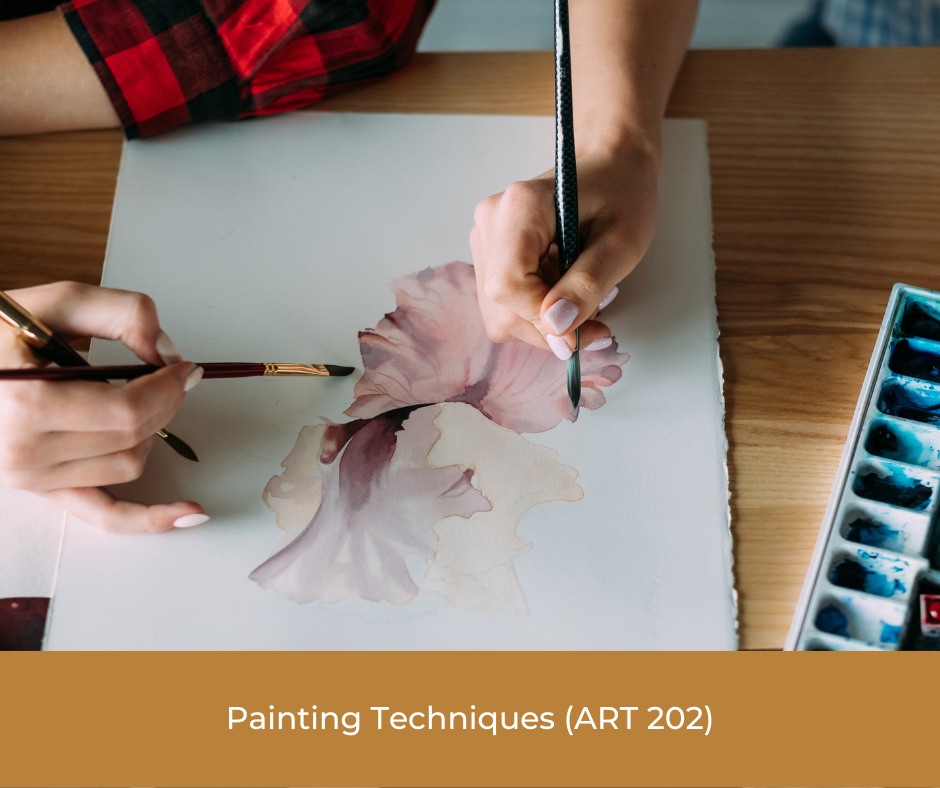Course Description
Painting Techniques (ART 202) is an intermediate-level course that immerses students in the diverse realm of painting. This course encompasses a variety of painting techniques, including oil, acrylic, and watercolor. Through hands-on exploration, students delve into color theory, composition, brushwork, and the expressive potential of paint. Painting Techniques fosters students’ ability to create visually compelling and emotionally resonant paintings.
Outline of Major Content Areas
- Introduction to Painting Media: An overview of various painting media, including oil, acrylic, and watercolor. Students gain an understanding of the unique properties and applications of each medium.
- Color Theory: Exploration of color theory principles, including the color wheel, hue, value, saturation, and color harmonies. Students learn to manipulate color effectively.
- Composition: Study of compositional elements, such as balance, focal points, and visual hierarchy. Students acquire skills in arranging elements within a painting to create engaging compositions.
- Brushwork Techniques: In-depth exploration of brushwork techniques, including brush types, strokes, layering, and texture creation. Students develop control and precision in their brushwork.
- Still-Life Painting: Application of painting techniques to create vibrant still-life compositions. Students practice rendering objects and exploring color relationships.
- Landscape and Portraiture: Introduction to landscape and portrait painting. Students develop skills in capturing the essence of outdoor scenes and portraying the human figure.
- Expressive Painting: Encouragement of creative expression through painting. Students experiment with abstract and non-representational painting styles.
Course Learning Outcomes
Upon successful completion of Painting Techniques (ART 202), students will:
- Master Painting Media: Demonstrate proficiency in working with oil, acrylic, and watercolor paints, understanding their characteristics and techniques.
- Apply Color Theory: Utilize color theory principles to create harmonious and expressive color palettes in their paintings.
- Compose Effectively: Create well-balanced and visually engaging compositions in various painting styles.
- Execute Brushwork: Exhibit control and dexterity in brushwork, achieving desired textures and effects.
- Paint Still-Life: Render realistic and expressive still-life arrangements, showcasing an understanding of form, light, and shadow.
- Paint Landscapes and Portraits: Successfully paint landscapes that capture the beauty of outdoor scenes and portraits that convey the essence of the subject.
- Express Creativity: Explore and express their creative voices through abstract and non-representational painting styles.
Methods for Assessing Student Learning
Assessment in Painting Techniques (ART 202) focuses on evaluating students’ technical skills, artistic expression, and conceptual understanding. Assessment methods include:
- Painting Projects: Students will complete a series of painting projects that explore different techniques, styles, and subjects.
- Critiques: Regular critiques, facilitated by peers and the instructor, offer constructive feedback on the artistic and technical aspects of students’ work.
- Color Theory Assignments: Assignments related to color theory principles, color mixing, and the application of color in painting.
- Final Portfolio: Students will compile a portfolio of their best paintings from the course, demonstrating their artistic growth and proficiency.
- Written Reflections: Short written reflections on their own paintings and the works of established artists, encouraging critical thinking and self-assessment.
Painting Techniques (ART 202) empowers students to explore the limitless possibilities of painting, from traditional techniques to innovative approaches, fostering their growth as skilled and expressive painters.
